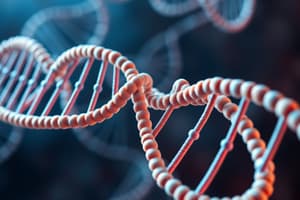Podcast
Questions and Answers
What describes chromatin in a non-dividing cell?
What describes chromatin in a non-dividing cell?
- Made only of RNA
- Visible during cell division
- Highly coiled and compact
- Less coiled and long (correct)
Which enzyme is responsible for adding nucleotides during DNA replication?
Which enzyme is responsible for adding nucleotides during DNA replication?
- Primase
- RNA Polymerase
- DNA Polymerase (correct)
- Helicase
What is the status of chromosomes during cell division?
What is the status of chromosomes during cell division?
- Non-visible in the nucleus
- Formed exclusively of RNA
- Uncoiled and dispersed
- Compacted and visible (correct)
What is the result of DNA replication?
What is the result of DNA replication?
Why is DNA replication important for cells?
Why is DNA replication important for cells?
What are the building blocks of DNA called?
What are the building blocks of DNA called?
Which nitrogen bases pair together in DNA?
Which nitrogen bases pair together in DNA?
How does the sequence of nitrogen bases in DNA contribute to an organism's characteristics?
How does the sequence of nitrogen bases in DNA contribute to an organism's characteristics?
What is the role of proteins made from genes in cells?
What is the role of proteins made from genes in cells?
What type of structure does DNA form?
What type of structure does DNA form?
What must happen to DNA before mitosis?
What must happen to DNA before mitosis?
What are histones and their role in DNA packaging?
What are histones and their role in DNA packaging?
What information do genes carry?
What information do genes carry?
Phosphates and sugars are the backbones to the double helix.
Phosphates and sugars are the backbones to the double helix.
Flashcards
Chromatin
Chromatin
Long and thin form of DNA in a non-dividing cell, less coiled, easily accessible for protein synthesis.
Chromosomes
Chromosomes
Compact, coiled form of DNA found in a dividing cell, visible under a microscope, helps prevent tangling of DNA during cell division.
DNA Replication
DNA Replication
The process of creating an exact copy of a DNA molecule.
Helicase
Helicase
Signup and view all the flashcards
DNA Polymerase
DNA Polymerase
Signup and view all the flashcards
Nucleotide
Nucleotide
Signup and view all the flashcards
Nitrogenous Bases
Nitrogenous Bases
Signup and view all the flashcards
Base Pairing
Base Pairing
Signup and view all the flashcards
Double Helix
Double Helix
Signup and view all the flashcards
Gene
Gene
Signup and view all the flashcards
Histones
Histones
Signup and view all the flashcards
Protein Synthesis
Protein Synthesis
Signup and view all the flashcards
Study Notes
DNA Structure
- DNA is a deoxyribonucleic acid
- Nucleotides are the building blocks of DNA
- Deoxyribose sugar
- Phosphate group
- Nitrogenous base (adenine, thymine, guanine, cytosine)
- Nitrogenous bases pair up:
- Adenine with Thymine
- Guanine with Cytosine
- Base pairs are held together by hydrogen bonds
- DNA forms a double helix, a twisted ladder shape
- The order and number of bases determine the unique characteristics of organisms
DNA Function
- DNA stores hereditary information
- Each gene in DNA provides instructions to make a protein
- Proteins have various functions in cells (enzymes, transport, structural, etc.)
DNA Packaging
- DNA in eukaryotic cells is long and thin and wrapped around proteins called histones
- This complex is called chromatin
- Chromatin condenses to form chromosomes during cell division
- Chromosomes are visible in dividing cells and not in non-dividing cells
DNA Replication
- Replication is the process of creating a copy of DNA
- It's important for making new body cells during mitosis
- Helicase breaks hydrogen bonds between base pairs, separating the strands
- DNA polymerase adds complementary bases to each strand, creating two identical DNA molecules
- Each new DNA molecule has one original strand and one newly synthesized strand
Studying That Suits You
Use AI to generate personalized quizzes and flashcards to suit your learning preferences.




